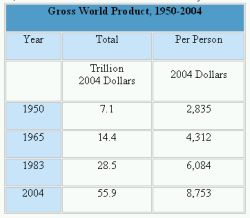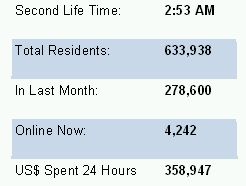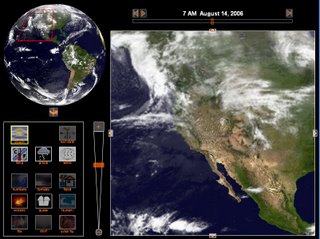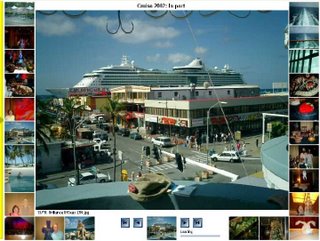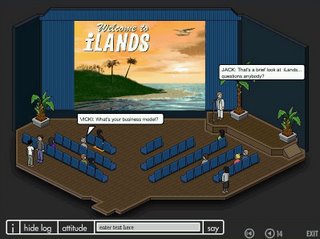Profiles: As we explored the implications of this
 scenario, we soon realized that people need a reason to interact and we added profiles. The profile envisioned was a combination of anything the user wanted to share with others (perhaps their city and country, or some of their interests) and things the user did in public (their history--time spent on iLands, in buildings or in presentations; their questions or publications) tracked automatically by the enviroment. We made parts of the profile accessible by a simple user action and other parts automatically matched with others in the same room or building so common interests or history could be pointed out to the user. And if two profiles correlated highly they could also be used to provide "collaborative filtering" suggestions of other things to do, buildings to visit, presentations at attend.
scenario, we soon realized that people need a reason to interact and we added profiles. The profile envisioned was a combination of anything the user wanted to share with others (perhaps their city and country, or some of their interests) and things the user did in public (their history--time spent on iLands, in buildings or in presentations; their questions or publications) tracked automatically by the enviroment. We made parts of the profile accessible by a simple user action and other parts automatically matched with others in the same room or building so common interests or history could be pointed out to the user. And if two profiles correlated highly they could also be used to provide "collaborative filtering" suggestions of other things to do, buildings to visit, presentations at attend.Public Spaces: We added public spaces
 (settings where avatars could move around and cluster seemed to be important) for people to interact and multiple conversations could occur simultaneously. With the technology available, we used text "talking" and show talk in cartoon-like balloons near the speaker. They would blossom forth when text was received and slowly fade. We had contemplated fading dependent upon avatar's distance from the conversation but technological limitation limited us to the god view.
(settings where avatars could move around and cluster seemed to be important) for people to interact and multiple conversations could occur simultaneously. With the technology available, we used text "talking" and show talk in cartoon-like balloons near the speaker. They would blossom forth when text was received and slowly fade. We had contemplated fading dependent upon avatar's distance from the conversation but technological limitation limited us to the god view.Meetings: Meetings were another challenge.
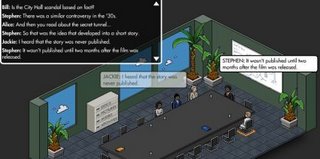 Multiple avatars could be talking and all could take part. We decided to have a scrollable record of the conversation--assuming there was only one conversation for the meeting. There was also a white board for sharing materials in a mutually viewable space. Files and other materials for the meeting could be stored until needed in local file cabinets.
Multiple avatars could be talking and all could take part. We decided to have a scrollable record of the conversation--assuming there was only one conversation for the meeting. There was also a white board for sharing materials in a mutually viewable space. Files and other materials for the meeting could be stored until needed in local file cabinets.Presentations: A large auditorium for presentations
 was another opportunity to tune the interface for the intended interactions. The main dialog was one to many but questions from the audience were also permitted. Power point presentations appeared on a screen in the front of the hall. We contemplated that additional people may want to view the presentation after it was made. So presentations were recorded. Part of the interest in attending a presentation is interacting with other attending, so we permitted profiles to be queried and matched. Now if the presentation was attended after the fact, via the recording, the same functionality could be provided...making a "living" presentation. Of course, dialog with past attendees or with the presenter may not continue synchronously but we're all used to asynchronous communication via email, delayed instant messaging and phone messages.
was another opportunity to tune the interface for the intended interactions. The main dialog was one to many but questions from the audience were also permitted. Power point presentations appeared on a screen in the front of the hall. We contemplated that additional people may want to view the presentation after it was made. So presentations were recorded. Part of the interest in attending a presentation is interacting with other attending, so we permitted profiles to be queried and matched. Now if the presentation was attended after the fact, via the recording, the same functionality could be provided...making a "living" presentation. Of course, dialog with past attendees or with the presenter may not continue synchronously but we're all used to asynchronous communication via email, delayed instant messaging and phone messages.
